Mount Tai
| Mount Tai | |
|---|---|
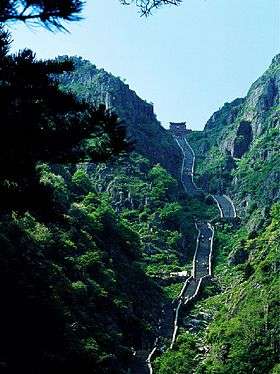 The South Gate to Heaven at Mount Tai | |
| Highest point | |
| Elevation | 1,532.7 m (5,029 ft) |
| Prominence | 1,505 m (4,938 ft) [1] |
| Listing | Ultra |
| Coordinates | 36°15′21″N 117°06′27″E / 36.25583°N 117.10750°ECoordinates: 36°15′21″N 117°06′27″E / 36.25583°N 117.10750°E [1] |
| Geography | |
 Mount Tai Location on the North China Plain | |
| Location | Tai'an, Shandong |
| Geology | |
| Age of rock | Cambrian |
| Mountain type | metamorphic, sedimentary |
| Climbing | |
| Easiest route | cable car |
| Official name | Mount Taishan |
| Type | Mixed |
| Criteria | i, ii, iii, iv, v, vi, vii |
| Designated | 1987 (11th session) |
| Reference no. | 437 |
| State Party | People's Republic of China |
| Region | Asia-Pacific |
| Mount Tai | |||||||||||||||||||||||||||||||||
|
"Mount Tai" in Chinese characters | |||||||||||||||||||||||||||||||||
| Chinese | 泰山 | ||||||||||||||||||||||||||||||||
|---|---|---|---|---|---|---|---|---|---|---|---|---|---|---|---|---|---|---|---|---|---|---|---|---|---|---|---|---|---|---|---|---|---|
| Literal meaning | "Mount Tai" | ||||||||||||||||||||||||||||||||
| |||||||||||||||||||||||||||||||||
| Alternative Chinese name | |||||||||||||||||||||||||||||||||
| Chinese | 岱山 | ||||||||||||||||||||||||||||||||
| |||||||||||||||||||||||||||||||||
Mount Tai (Chinese: 泰山; pinyin: Tài Shān) is a mountain of historical and cultural significance located north of the city of Tai'an, in Shandong province, China. The tallest peak is the Jade Emperor Peak (simplified Chinese: 玉皇顶; traditional Chinese: 玉皇頂; pinyin: Yùhuáng Dǐng), which is commonly reported as 1,545 metres (5,069 ft) tall,[2] but is described by the PRC government as 1,532.7 metres (5,029 ft).[3]
Mount Tai is known as the eastern mountain of the Five Great Mountains of China. It is associated with sunrise, birth, and renewal, and is often regarded the foremost of the five. Mount Tai has been a place of worship for at least 3,000 years and served as one of the most important ceremonial centers of China[4] during large portions of this period.
Location

Mount Tai is located in western Shandong, just north of the city of Tai'an and to the south of the provincial capital Jinan. It extends from 150 to 1,545 metres (492 to 5,069 ft) above sea level and covers an area of 426 square kilometres (164 sq mi) at its base. The Jade Emperor Peak is 1,532.7 metres (5,029 ft) above sea level and located at 36° 16′N and 117° 6′E.
History
Traces of human presence at Mount Tai date back to the Paleolithic period. Human settlement of the area can be proven from the neolithic period onwards. During this time, two cultures had emerged near the mountain, the Dawenkou culture to the south and the Longshan culture to the north.
During the Xia Dynasty (c. 2070–1600 BC) the mountain was known as Mount Dai (Chinese: 岱山; pinyin: Dài Shān) and lay within the borders of Qingzhou, one of the Nine Provinces of ancient China.[5]
Religious worship of Mount Tai has a tradition dating back 3,000 years, from the time of the Shang (c. 1600–1046 BC) to the Qing Dynasty (1644–1912). Over time, this worship evolved into an official imperial rite and Mount Tai became one of the principal places where the emperor would pay homage to heaven (on the summit) and earth (at the foot of the mountain) in the Feng (Chinese: 封; pinyin: Fēng) and Shan (Chinese: 禪; pinyin: Shàn) sacrifices respectively. The two sacrifices are often referred to together as the Fengshan sacrifices (Chinese: 封禪; pinyin: Fēngshàn). Carving of an inscription as part of the sacrifices marked the attainment of the "great peace".[6]
By the time of the Zhou Dynasty (c. 1046–256 BC) sacrifices at Mount Tai had become highly ritualized ceremonies in which a local feudal lord would travel there to make sacrifices of food and jade ritual items. These would then be arranged in a ritually correct pattern before being buried on the mountain. In the Spring and Autumn period (771–476 BC) the vassal states of Qi and Lu bordered Mount Tai to the north and south respectively, from where their feudal lords both made independent sacrifices on Mount Tai. According to Zhou ritual belief, the spirit of Mount Tai would only accept sacrifices offered by a feudal lord, leading Confucius (in his Analects 3.6) to criticize the ministers who offered state sacrifices here after usurping power.[7] In the ensuing Warring States period (475–221 BC), to protect itself against invasion, the State of Qi erected a 500 kilometres (310 mi) wall, the ruins of which are still present today. The name Tai'an of the neighboring city is attributed to the saying "If Mount Tai is stable, so is the entire country" (both characters of Tai'an, "泰" and "安", have the independent meaning of "peace").
In 219 BC, Qin Shi Huang, the first Emperor of China, held a ceremony on the summit and proclaimed the unity of his empire in a well-known inscription. During the Han Dynasty (206 BC–220 AD), the Feng and Shan sacrifices were considered the highest of all sacrifices.[6]
Rituals and sacrifices were conducted by the Sui.[8]
Japan, India, the Persian court in exile, Goguryeo, Baekje, Silla, the Turks, Khotan, the Khmer, and the Umayyad Caliphate all had representatives attending the Feng and Shan sacrifices held by Emperor Gaozong of Tang in 666 at Mount Tai.[9]
Mount Tai has been a UNESCO World Heritage Site since 1987. In 2003, it attracted around 6 million visitors. A renovation project was completed in late October 2005, which aimed at restoring cultural relics and renovating damaged buildings of cultural significance. Widely known for its special ceremonies and sacrifices, Mount Tai has seen visits by many poets and literary scholars who have traveled there to gain inspiration. There are grandiose temples, many stone inscriptions and stone tablets with the mountain playing an important role in the development of both Buddhism and Taoism.[10]
Natural significance
Mount Tai is a tilted fault-block mountain with height increasing from the north to the south. It is the oldest example of a paleo-metamorphic formation from the Cambrian Period in eastern China. Known as the Taishan Complex, this formation contains magnetized, metamorphic, and sedimentary rock as well as intrusions of other origins during the Archean Era. The uplift of the region started in the Proterozoic Era; by the end of the Proterozoic, it had become part of the continent.
Besides the Jade Emperor Peak, other distinctive rock formations are the Heaven Candle Peak, the Fan Cliff, and the Rear Rock Basin.
Mount Tai lies in the zone of oriental deciduous forest; about 80% of its area is covered with vegetation. The flora is known to comprise almost 1,000 species. Some of the trees in the area are very old and have cultural significance, such as the Han Dynasty Cypresses, which were planted by the Emperor Wu Di, the Tang Chinese Scholartree (about 1,300 years old), the Welcoming-Guest Pine (500 years old) and the Fifth-Rank Pine, which was named originally by the Emperor Qin Shi Huang, but was replanted about 250 years ago.
Physical features
Mount Taishan rises abruptly from the vast plain of central Shandong, and is naturally endowed with many scenic sites. Geologically, it is a tilted fault-block mountain, higher to the south than north, and is the oldest and most important example of the paleo-metamorphic system representative of the Cambrian Period in eastern China. Referred to as the Taishan Complex, it comprises magnetized, metamorphic, sedimentary rock and an intrusive mass of various origins that were formed in the Archean Era 1700-2000 million years ago. Subsequently, in the Proterozoic Era, the Taishan region began to rise, becoming part of the continent by the end of the era. Uplift continued until the middle of the Cenozoic Era. The gneiss which emerged in the Taishan region is the foundation for all of North China. Cambrian strata, fully emerged in the north, are rich in fossils. Six streams flow from the summit, their water renowned for its extremely low mineral content, slight acidity (pH = 6.3) and relatively high oxygen content (6.4 milligrams per liter (mg/l)).
Climate
The area falls within the warm temperate climatic zone. Meteorological data is not available.
Vegetation
Vegetation covers 79.9% of the area, which is densely wooded, but information about its composition is lacking. The flora is diverse and known to comprise 989 species, of which 433 species are woody and the rest herbaceous. Medicinal plants total 462 species and include multiflower knotweed, Taishan ginseng, Chinese gromwell and sealwort, which are renowned throughout the country. Some trees are very old and famous, notably the Han Dynasty Cypresses (planted 2,100 years ago by Emperor Wu Di of the Han Dynasty), 'Welcoming Guest Pine' (500 years old) and 'Fifth Rank Pine' (named by Emperor Qin Shi Huang of the Qin Dynasty and replanted some 250 years ago).
Fauna
There are over 200 species of animals in addition to 122 species of birds, but precise details are lacking. Large-scaled fish Varicorhinus macrolepis is found in running water at 300–800 m.
Cultural significance


Mount Tai is of key importance in Chinese religion, being the eastern one of the five Sacred Mountains of China. According to historical records, Mount Tai became a sacred place haunted by emperors to offer sacrifices and meditate in the Zhou Dynasty before 1,000 BC. A total of 72 emperors were recorded as visiting it. Writers also came to acquire inspiration, to compose poems, write essays, paint and take pictures. Hence, a great many cultural relics were left on the mountain.
Deities associated to Mount Tai
Great Deity of Mount Tai
The Great Deity of Mount Tai (Chinese: 东岳大帝; pinyin: Dōngyuè Dàdì) is the supreme god of Mount Tai. According to one mythological tradition, he is a descendant of Pangu. According to other theologies, he is the eastern one of the Five Manifestations of the Highest Deity (Wufang Shangdi).
Bixia Yuanjun
Bixia Yuanjun (Chinese: 碧霞元君; pinyin: Bìxiá Yuánjūn), literally the "Goddess of the Blue Dawn", also known as the "Heavenly Immortal Lady of Jade" (Chinese: 天仙玉女; pinyin: Tiānxian Yùnǚ) or the "Lady of Mount Tai" (Chinese: 泰山娘娘; pinyin: Tàishān Niangniang). According to some mythological accounts, she is the daughter or the consort of the Great Deity of Mount Tai. Statues of Bixia Yuanjun often depict her holding a tablet with the Big Dipper as a symbol of her authority.
Yanguang Nainai
Yanguang Nainai (Chinese: 眼光奶奶; pinyin: Yǎnguāng Nǎinǎi) is venerated as goddess of eyesight and often portrayed as an attendant to Bixia Yuanjun.
Songzi Niangniang
Songzi Niangniang (Chinese: 送子娘娘; pinyin: Sòngzi Niangniang) is seen as a goddess of fertility, like Yanguang Nainai, she is often portrayed as an attendant to Bixia Yuanjun.
Shi Gandang
Shi Gandang (Chinese: 石敢当; pinyin: Shígǎndāng) is a spirit sent down from Mount Tai by Bixia Yuanjun to protect ordinary people from evil spirits.
Dai Miao
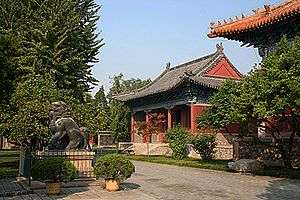
The Temple of the God of Mount Tai, known as the Dai Temple (Chinese: 岱庙; pinyin: Dàimiào), is the largest and most complete ancient building complex in the area. It is located at the foot of Mount Tai in the city of Tai'an and covers an area of 96,000 square meters. The temple was first built during the Qin Dynasty. Since the time of the Han Dynasty (206 BC – 220 AD), its design has been a replica of the imperial palace, which makes it one out of three extant structures in China with the features of an imperial palace (the other two are the Forbidden City and the Confucius Temple in Qufu). The temple has five major halls and many small buildings. The centerpiece is the Palace of Heavenly Blessings (Tian Kuang), built in 1008, during the reign of the last Northern Song Emperor Huizong. The hall houses the mural painting "The God of Mount Tai Making a Journey", dated to the year 1009. The mural extends around the eastern, western and northern walls of the hall and is 3.3 metres high and 62 metres long. The theme of the painting is an inspection tour by the god. Next to the Palace of Heavenly Blessings stand the Yaocan Pavilion and the entrance archway as well as the Bronze Pavilion in the northeast corner. The Dai Temple is surrounded by the 2,100‑year‑old Han Dynasty cypresses. The oldest surviving stair may be the 6000 granite steps to the top of the mountain.
The site contains a number of well-preserved steles from the Huizong reign, some of which are mounted on bixi tortoises. There is a much later, Qianlong era bixi-mounted stele as well.[11]
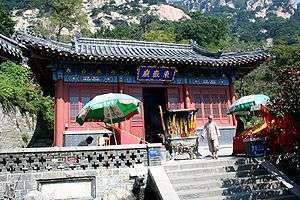
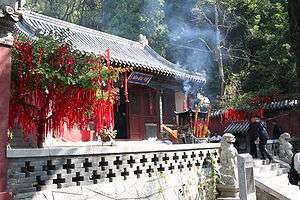
Shrine of the Blue Dawn
The Shrine of the Blue Dawn (Chinese: 碧霞祠; pinyin: Bìxiá Cí), near the top of the mountain is another grand building complex, a special combination of metal components, wood, and bricks and stone structures. It is dedicated to the goddess Bixia (Blue Dawn). From the Taishan Temple to the Blue Dawn Temple there are numerous stone tablets and inscriptions and ancient buildings on the way. Visitors derive much pleasure from climbing Mount Taishan. From the red gate at the foot of the mountain to the South Heaven Gate at the top are some 6,660 stone steps, which wind their way up the mountain slopes, each step offering a different view.
Shibapan
The"Shibapan"(十八盘)means 18 levels stairs,which is the most advantageous part of stairs in Mount Tai. A total of 1827 stone steps, is one of the main signs Mount Tai. People always say:"Mount Tai of the majestic, all in Shibapan, Mount Tai of the sublime, all in the climb in!" Shibapan has three parts, the"Slow Eighteens"(紧十八), the "Hard Eighteens"(慢十八), and the " No slow no hard Eighteens"(不紧不慢又十八). The "Slow Eighteens" means this period is easier to climb, and the"Hard Eighteens" means it is harder to climb, which is interesting.
Other monuments
A flight of 7,200 total steps (including inner temple steps), with 6,293 Official Mountain Walkway Steps, lead up the East Peak of Mount Tai, along its course, there are 11 gates, 14 archways, 14 kiosks, and 4 pavilions.
In total, there are 22 temples, 97 ruins, 819 stone tablets, and 1,018 cliff-side and stone inscriptions located on Mount Tai. These include a Temple of the Jade King (Chinese: 玉皇庙; pinyin: Yùhuáng Miào), a Temple of the Blue Deity (Chinese: 青帝宫; pinyin: Qīngdì Gōng), a Temple of Confucius (Chinese: 孔子庙; pinyin: Kǒngzi Miào), a Temple of Doumu (Chinese: 斗母宫; pinyin: Dòumǔ Gōng) and the Puzhao Buddhist Temple (Chinese: 普照寺; pinyin: Pǔzhào Sì).
Among the tablets and inscriptions on the top of Mount Tai, the inscription that declares Mount Tai the "Most Revered of the Five Sacred Mountains" (simplified Chinese: 五岳独尊; traditional Chinese: 五嶽獨尊; pinyin: Wǔyuè Dúzūn) on the "Sun Viewing Peak" (Chinese: 日观峰; pinyin: Rìguān Fēng) is particularly renown. It was written by a member of the Aisin Gioro clan (Chinese: 爱新觉罗玉构; pinyin: Àixīn Juéluō Yùgòu) in 1907 and is featured on the reverse side of the 5 yuan bill of the 5th series renminbi banknotes. Another inscription marks the "Lu-Viewing Platform" (Chinese: 瞻鲁台; pinyin: Zhānlǔ tái) from which Confucius took in the view over his home state of Lu and then pronounced "The world is small".
The Wordless Stela (Chinese: 无字碑; pinyin: Wúzì Bēi) stands in front of the Jade Emperor Temple. Legend has it that the emperor who commissioned the stela was dissatisfied with the planned inscription and decided to leave it blank instead.
Other significant places
- Abandoning-Oneself Cliff (Chinese: 舍身崖; pinyin: Shěshēn Yá), renamed Treasure Life Cliff (Chinese: 爱身崖; pinyin: Àishēn Yá) in the Ming Dynasty
- Sun Viewing Peak (Chinese: 日观峰; pinyin: Rìguān Fēng)
- Moon Viewing Peak (Chinese: 月观峰; pinyin: Yuèguān Fēng)
- Lu-Viewing Platform (Chinese: 瞻鲁台; pinyin: Zhānlǔ Tái)
- Explore the Sea of Clouds Rock (Chinese: 探海石; pinyin: Tànhǎi Shí)
Infrastructure
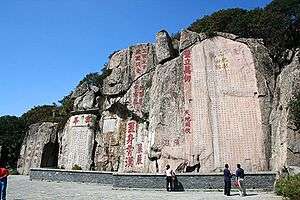
Visitors can reach the peak of Mount Tai via a bus which terminates at the Midway Gate to Heaven, from there a cable car connects to the summit. Covering the same distance on foot takes from two and a half to six hours. The supplies for the many vendors along the road to the summit are carried up by porters either from the Midway Gate to Heaven or all the way up from the foot of the mountain.
To climb up the mountain, one can take one of two routes. The more popular east route starts from Taishan Arch. On the way up the 7,200 stone steps, the climber first passes the Ten Thousand Immortals Tower (Wanxianlou), Arhat Cliff (Luohanya), and Palace to Goddess Dou Mu (Doumugong). The climbing from the First Gate to Heaven (yi1 tian1 men2), the main entrance bordering on Tai'an town, up the entire mountain can take two and a half hours for the sprinting hiker to six hours for the leisure pace. Reaching the Midway Gate to Heaven from First Gate to Heaven is one hour at a sprint up to two and a half hours leisurely. To the northeast of the Palace to Goddess Dou Mu is Sutra Rock Valley in which the Buddhist Diamond Sutra was cut in characters measuring fifty centimeters across believed to be inscribed in the Northern Wei Dynasty. The west route, taken by fewer tourists, is more scenic, but has less cultural heritage.
Cultural references

- The Chinese idiom "Mount Tai & Big Dipper" (Chinese: 泰山北斗; pinyin: Tàishān Bĕidŏu) is an epithet for a person of great distinction.
- Another common Chinese idiom "有眼不識泰山" (literal translation Has eyes but doesn't recognize Mount Tai), refers to an ignorant yet arrogant person.
- According to ancient historian Sima Qian, he said "Though death befalls all men alike, it may be weightier than Mount Tai or lighter than a feather."[12] Mao Zedong referred to this passage in the 20th century: "To die for the people is weightier than Mount Tai, but to work for the fascists and die for the exploiters and oppressors is lighter than a feather."[13] Rage Against the Machine also referred to the passage in the song "Year of the Boomerang": "So I'm goin' out heavy sorta like Mount Tai."[14]
- Taishan (Mount Tai) is referenced extensively in Ezra Pound's "The Cantos," especially the Pisan Cantos.
- Mount Tai is shown on the reverse side of the 5 yuan bill of the 5th series renminbi banknotes.
- The 1987 album Hold Your Fire by Canadian progressive rock band Rush contained the song "Tai Shan", referencing drummer/lyricist Neil Peart's journey to Mount Tai.
- The Dai Miao is featured in Sid Meier's Civilization IV as a religious complex that can be built by a Great Prophet, thus establishing a holy shrine dedicated to Taoism in the Taoist holy city.
- Tai Shan, some of its temples, and the Jade Emperor are referenced and visited in Dan Simmons' book The Rise of Endymion.
- Mt. Tai is referenced as being the place of origin for the Taizan Tenrōken (泰山天狼拳, "Mt. Tai Celestial Wolf Fist") martial art in Fist of the North Star, used by Yuria's elder brother, Ryuga.
See also
References
- 1 2 "Central and Eastern China, Taiwan and Korea" Peaklist.org. Listed as "Tai Shan". Prominence based on an elevation of 1,545 m and a col of 40 m. Retrieved 2011-11-19.
- ↑ Yuan Xingzhong; Hong, Liu (2000). "Studies on the diversity of soil animals in Taishan Mountain". Journal of Forestry Research. 11 (2): 109–113. doi:10.1007/BF02856685. Archived from the original (– Scholar search) on 2007-09-30. Retrieved 2007-06-04.
- ↑ China Announced Elevation of 19 Well-known Mountains, China Institute of Geo-Environment Monitoring, 19 May 2007. Accessed 4 June 2007.
- ↑ "Mount Tai". Encyclopedia Britannica. Retrieved 31 January 2015.
- ↑ "Introduction to Qingzhou (青州城市概況)" (in Chinese). Qingzhou Government Website. Retrieved January 13, 2014.
- 1 2 "Writing and Authority in Early China". google.com. Retrieved 31 January 2015.
- ↑ Slingerland, Edward G. (Trans. & Ed.). Confucius Analects: With Selections from Traditional Commentaries. Indianapolis, IN: Hackett. 2003. ISBN 978-087220-635-9. Retrieved November 17, 2012. p.19.
- ↑ John Lagerwey; Pengzhi Lü (30 October 2009). Early Chinese Religion: The Period of Division (220-589 Ad). BRILL. pp. 84–. ISBN 90-04-17585-7.
- ↑ Skaff 2012, pp. 146-7.
- ↑ tai mountain
- ↑ Photos from Dai Miao (Chinese)
- ↑ "中国万花筒". google.com. Retrieved 31 January 2015.
- ↑ "SERVE THE PEOPLE". marxists.org. Retrieved 31 January 2015.
- ↑ "Rage Against The Machine Year Of Tha Boomerang lyrics"
External links
| Wikimedia Commons has media related to Mount Tai. |
-
 Mount Tai travel guide from Wikivoyage
Mount Tai travel guide from Wikivoyage - Tai Shan official website (English)
- WCMC Description
- "Tai Shan, China" on Peakbagger
.svg.png)
.jpg)
